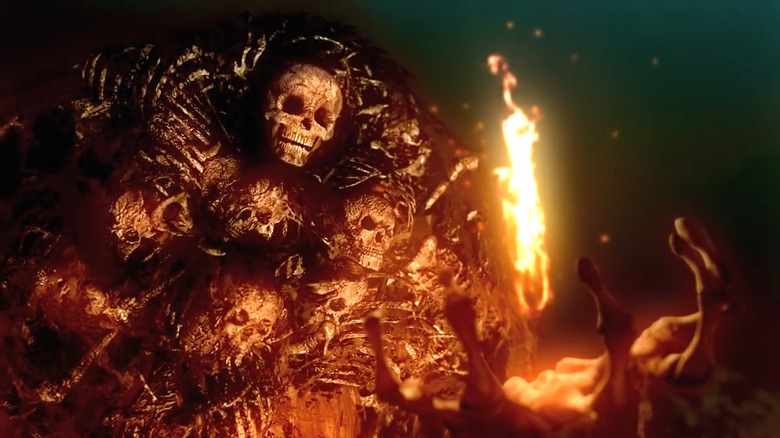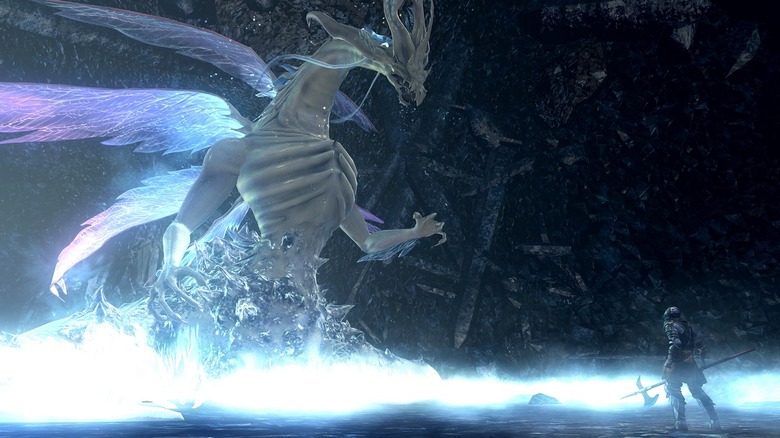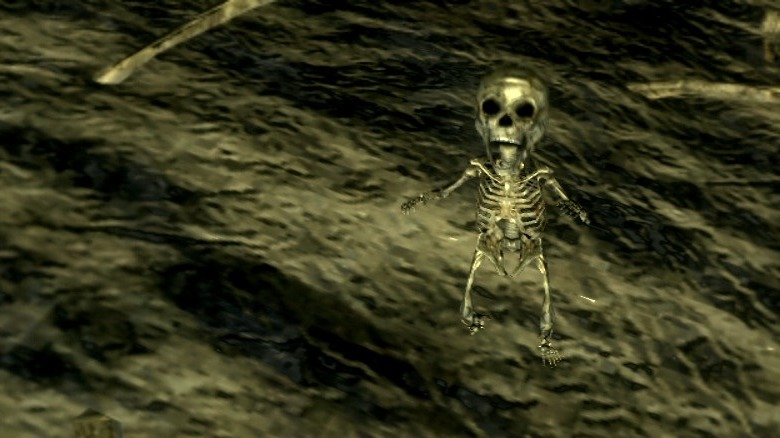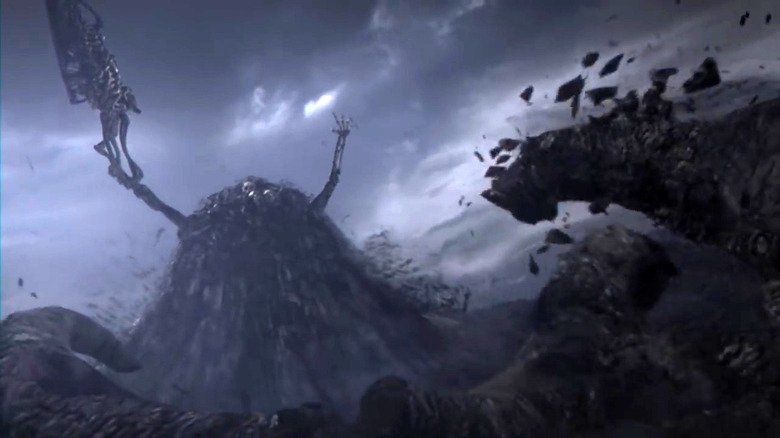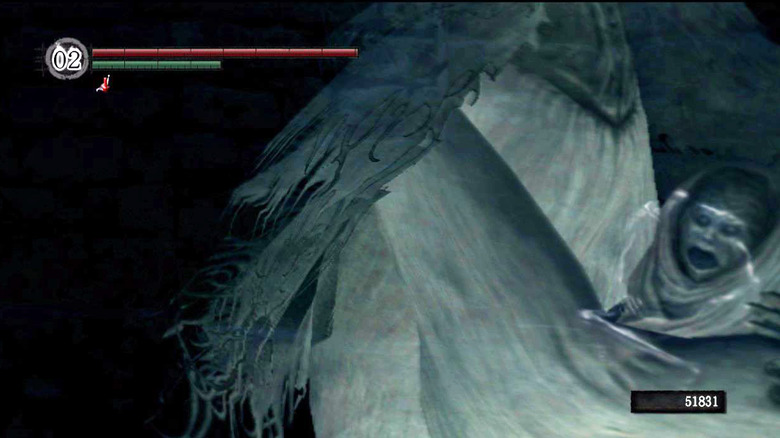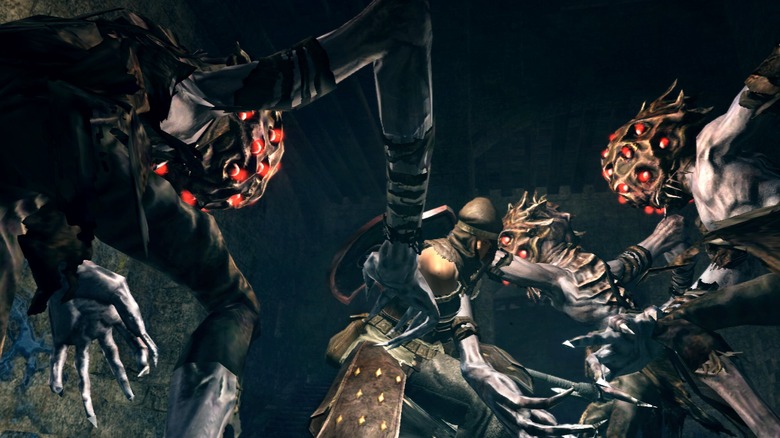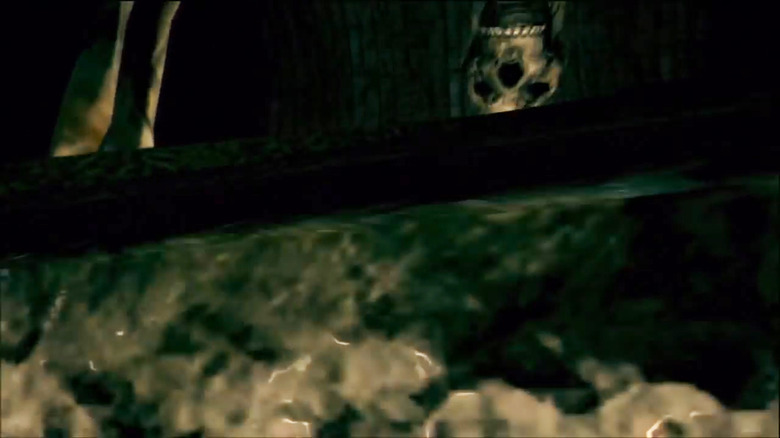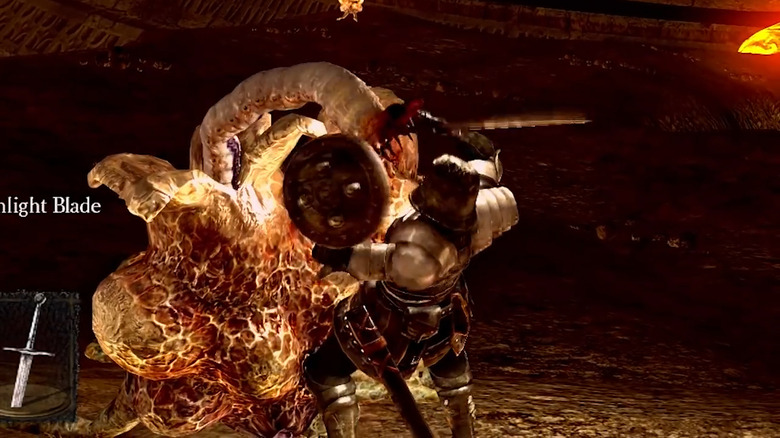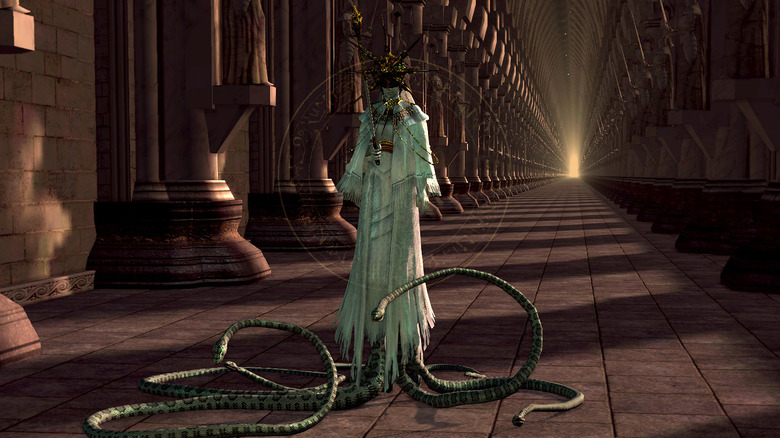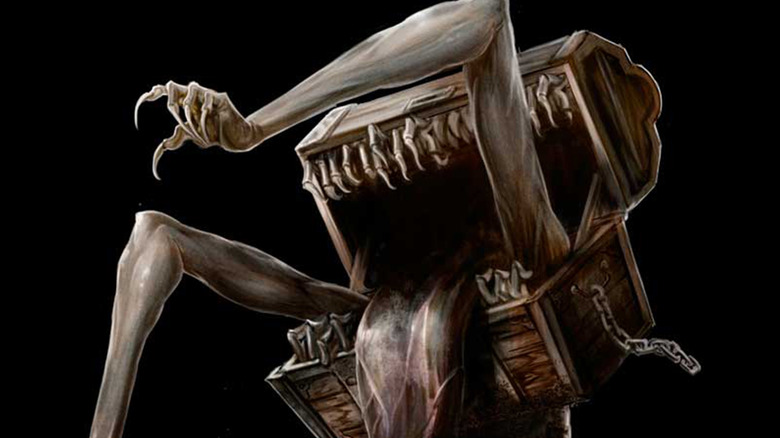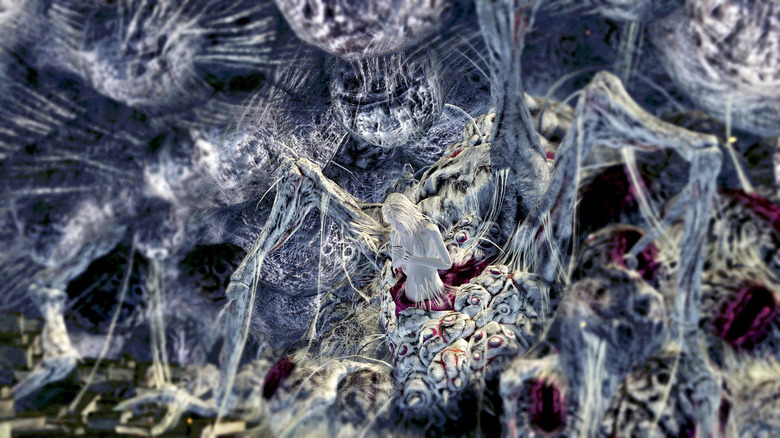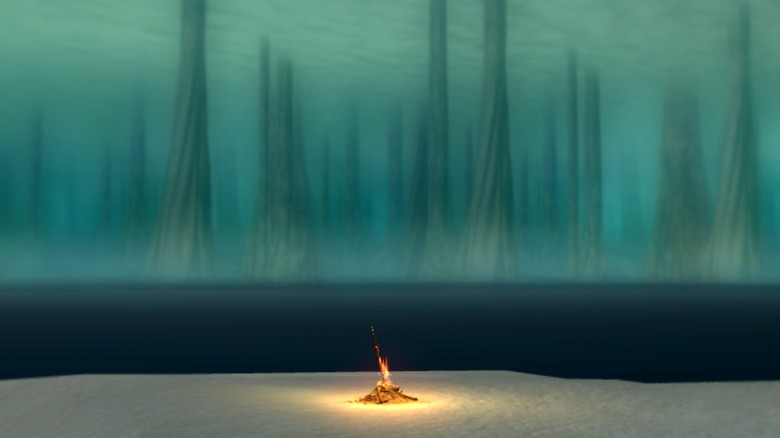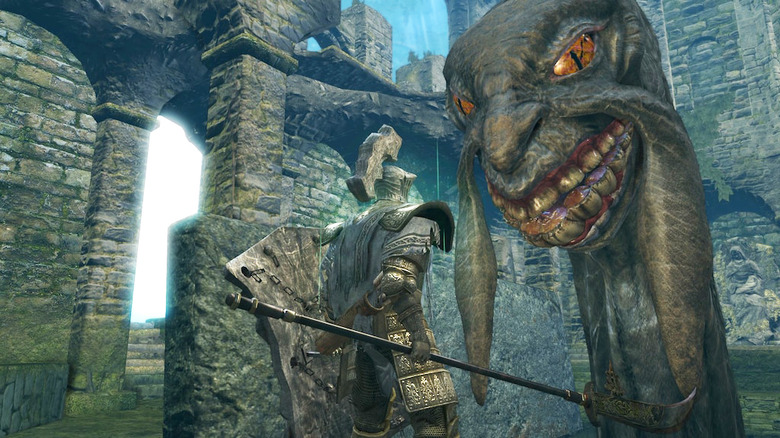The Creepiest Things We Found In Dark Souls
FromSoftware's Dark Souls redefined action-adventure video gaming. IGN told gamers in 2011 that "if you're interested in the limits of the video game form — to see just how focused, how pure and how uncompromising in its vision a game can be — Dark Souls is unmissable." And if the critical praise heaped upon it by industry tastemakers isn't enough to convince you, the game's rabid fanbase and legion of shameless imitators should do the trick (looking at you, Lords of the Fallen).
But with so much focus on the game's challenging gameplay and punishing boss battles, the conversation around its special brand of dark fantasy has sometimes grown as obscure as the legend of lost Oolacile or the fate of Gwyn's firstborn. Dark Souls is a game that utilizes horror as often as (if not more so than) any other genre during its robust depiction of time-honored fantasy tropes. To celebrate the darker side of Dark Souls, we're taking a look at the creepiest things we found in Lordran — from the illusion-haunted heights of Anor Londo to the shadowy depths of the Abyss itself.
Seath's insidious experiments
A large amount of the Dark Souls mystique emanates from the game's legendary boss battles, many of which feature some of the saga's most despicable villains. Take Seath the Scaleless, for instance, a pale dragon who earned his way into Anor Londo by betraying his own kind. Per the game's infamous prologue, after Seath's meddling, "the Dragons were no more." Yet, as vile as his origin story sounds, Seath's genocide of dragonkind was merely one of his many sordid accomplishments.
From his creation of the monstrous man-serpents and loathsome pisaca to his strangely covetous attitude towards royal maidens, Seath the Scaleless is arguably the game's creepiest non-player character. The pale drake conducts his horrible arcane experiments from the depths of the Duke's Archives in Anor Londo, and the aberrant results of these mystical meddlings can be found as far-off as the Darkroot Basin (which harbors the arcane-infused Moonlight Butterfly) and the Painted World of Ariamis (where the mysterious Crossbreed Priscilla, the most enigmatic of Seath's perversions, dwells in relative solitude). The Six-eyed Channelers assist Seath in "collecting human specimens," which you'll find several times on your long quest from the Undead Parish to Anor Londo. The farther you go, the easier it becomes to see that "the grandfather of sorcery" has his scaleless claws stuck in every corner of Lordran — an unsettling revelation, even by Dark Souls standards.
Skeleton babies in the Tomb of the Giants
Akin to the plague babies of Demon's Souls fame, the relentless skeleton babies located outside Gravelord Nito's lair in the Tomb of the Giants are arguably the creepiest enemy in the entire Dark Souls series. There isn't much lore to mine from item descriptions, for the humanity they drop is their only farmable resource — but perhaps there is actually something more to that coincidence, considering these skeletal infants are generally known as one of the most free-flowing source of humanity in the game. The item description for humanity reads: "This black sprite is called humanity, but little is known about its true nature. If the soul is the source of all life, then what distinguishes the humanity we hold within ourselves?" With those words in mind, the notion of slaughtering endless waves of children for personal reward (however undead they may be) kind of puts a knotted feeling in the pit of your stomach.
It seems the true terror of the skeleton babies might be more than their horrifying appearance, or the eerie noise they make splashing around their watery, torchlit graves, or even their proximity to the First of the Dead himself — the real creep factor of the skeleton babies is that they can expose how much we can subvert narrative truths for our own ill-gotten gains.
Gravelord Nito's raiment of bones
Things get really creepy in Dark Souls once you head through the lightless catacombs and tombs of giant undead to encounter Gravelord Nito, one of the franchise's most overtly horrific characters. The true visage of "The First of the Dead" is obscured, however, by Nito's hideous undulating garb of skulls and bones, an image that sticks with you from the first moment you see it in the game's opening cinematic. It's all too easy to imagine how utterly effective his "miasma of death and disease" can be when we witness his loathsome powers unfurl.
As the plot of the game slowly comes into view and players begin to realize they'll need to confront Nito in their quest for the Lord Souls, that inevitable battle with the Gravelord can inspire a lingering feeling of dread that perfectly accentuates the abhorrent darkness of both Tomb of the Giants and the Catacombs, sinister sections of the map that give the Abyss itself a run for its proverbial money. When you finally meet up with Nito — during pursuit of the Gravelord covenant or his epic boss battle — you'll get a close-and-personal look at the First of the Dead and how expertly he maintains his terrible title. If the old axiom that "the clothes make the man" holds true, one thing's for sure: Gravelord Nito is always on-brand.
Infants of the New Londo banshees
As a work of horror fantasy, Dark Souls is full to the brim with a variety of interesting undead creatures, each featuring their own distinct FromSoftware blend of traditionally-inspired lore and modern mechanical ingenuity. And even though the fleshy undead of areas like Blighttown or the skeletal cadavers of places like the Undead Parish can really creep you out, the ghosts of the New Londo Ruins are some of the spookiest enemies the game has to offer. But not all apparitions are created equal — there are two different spectral foes to be found in this watery antechamber to the Abyss. And the banshees are hands-down the area's apex phantoms.
Situationally difficult and narratively disturbing, the two banshees that haunt New Londo clutch a ghost blade in one hand and a silent undead infant in the other. Coupled with the knowledge of New Londo's grim history — that its inhabitants were drowned alive to seal the encroaching spread of Abyss — a close encounter with these ghostly mothers and their spectral progeny can really make your blood run cold. Well played, FromSoftware. Well played.
The oughlie residents of lost Oolacile
The Artorias of the Abyss DLC offered players new insights into some of the deepest lore of the Dark Souls saga, and took us all on a time-bending journey into the accursed past of Lost Oolacile, home to Manus — the Furtive Pygmy — and birthplace of the Abyss. And since this forsaken land is the true origin of the titular Dark Soul itself, it comes as no surprise that the regular denizens of Oolacile Township have become as affected by the Abyss as the city's forsaken steward, Knight Artorias.
Also known as "bloatheads", the abyss-corrupted humans of Oolacile have become monstrously aberrant horrors in the wake of Manus' arrival, sporting long, gangly arms and grossly misshapen heads covered in a multitude of red eyes. The bloathead sorcerers of Oolacile are particularly odious breed of enemy, sporting a mane of tendrils and a fiendish mouth rimmed in hideous barbed proboscises. Creepier still: you can wear their heads! From its biggest boss to its lowliest frontline enemies, Artorias of the Abyss raised the stakes in Dark Souls to incredibly dark heights — perhaps because it was cut content intended to appear in the game from the beginning. If that is the case (and it certainly is, by all FromSoftware accounts), then they saved some of the best, and creepiest, for last.
Nito's Gravelord henchman
Although it's the stuff of internet legend now, the esoteric rite required to enter the Gravelord covenant was among the most wily secrets Dark Souls had to offer when the game was originally released. Initiates of the Gravelord covenant must visit Nito himself via a certain inconspicuous sarcophagus located in the Catacombs near a stray titanite demon. During the transitional cutscene that takes the player from the Catacombs to Nito's lair in the Tomb of the Giants, you'll encounter a skulky unnamed henchman who creepily drags your sarcophagus through the shadows. We don't exactly know who this skeletal fellow is or precisely where he came from — and if you blink, you might miss him altogether — but true devotees of the Gravelord covenant recognize quality horror content when they see it.
The detail that really pushes this moment over the edge, and what separates it from other sequences in the game, is the temporary first-person perspective that engages once your character fully enters the coffin. It's a small touch that not only makes the scene spring to life, it serves as a pivotal reminder that: no matter how dark you think the world around the Chosen Undead has become, there are always darker, more horrific domains of Lordran that await your discovery (full of dreadful, unseen denizens designed to chill you to the bone).
Vile cargo of the egg carriers
Once players reach the Demon Ruins below the Great Swamp, the wildlife of Dark Souls grows immeasurably weirder. But no enemy of this chaotic and volcanic area evokes the sickening effects of Cronenberg-ish body horror quite like the egg carriers and the vile maggots they expel. If you're lucky enough to get a parasitic egg planted in your own head courtesy of a vile maggot bite, you'll need to seek out the egg vermifuge item to cure your rather grotesque condition. While the egg vermifuge item description is illuminating for would-be devotees of the Chaos Servant covenant, it only further obscures the realities of this strange parasitic life cycle: "The egg-bearers have chosen to serve the Flame of Chaos, and the eggs symbolize this selfless choice."
The unique egg carrier Eingyi offers a few more details, explaining that the parasite-infected servants of Chaos are "worse than Undead ... diseased, and unwanted. Like the grime of the Great Swamp." It's hard to say what's creepier: the huge egg-shaped growths on the backs of these supplicated once-human horrors, or the large parasitic worms that spring forth from them in a bloody spray of gore.
Dark Sun Gwyndolin's serpentine extremities
Anor Londo might seem abandoned by the gods, but that's far from the truth: the Dark Sun Gwyndolin lurks in shadowy catacombs beneath the city. And this lunar freakchild might not be the Lord of Sunlight's firstborn, but he is first on our list of Lordran's creepiest deities.
The story behind Anor Londo's pernicious pantheon is both tragic and circuitous, veiled in mystery just like the city itself is bathed in magical glamour to mask its dark truths. From his secret lair in the Darkmoon Tomb, Gwyndolin rules the illusory streets of Anor Londo with a strange and sinister agenda; and once either the false vision of his sister Gwynevere is dispelled or the player finds the Darkmoon Seance Ring in the Catacombs, we come to realize this taciturn covenant leader is "the only remaining deity in Anor Londo."
Gwyndolin's mastery of magic is astonishing, and there's a strange ambiguity about the sorceries and miracles of the soul arts that surround him. Even his way of speaking is suspiciously esoteric. The kid is creepy enough to begin with, but ... what the hell is going on with the half-dozen snake heads sprouting from beneath his robes? Perhaps Seath's mutated Man-Serpents or those pesky primordial serpents Frampt and Kaathe know something about it; we really just don't know. Simply put, Gwyndolin's lower body of undulating snakes is about as creepy as Dark Souls gets.
Mimic teeth are actually ... fingers!?
The mimics of Dark Souls are peculiar, horrifying creatures. The only real peek we have into their lore is from the item description for the Symbol of Avarice, which identifies the atypical helm as a "monster head resembling a treasure chest. Once an ancient god, it is said this is the symbol of shame imposed on a long lost clan, exiled for the sin of avarice. Wearing this slightly raises soul absorption and item discovery, but also affects its wearer with the curse of the branded." On top of its benefits, the weird helm slowly leeches 5 HP per second while you wear it, and is a wonderfully absurd tribute to the terrifying but slapstick monstrosity that spawns it.
There is an element of surrealism to FromSoftware's interpretation of this classic dungeon-dwelling aberration, which presents players with some of the most surprising deaths (and clutch treasures) Dark Souls has to offer. To the uninitiated, mimics look like ordinary wooden chests; but if you look closer, you'll notice a surreptitious chain placement and a steady swelling of the wood. And if the slow, rhythmic swell of a mimic's breathing isn't enough to make your skin crawl, the realization that its teeth are actually rows of skeletal fingers might be just what you need for a one-way trip to nightmare town. That's right: an extra close look at the pulsing maw of a mimic reveals that the subterfuge of these monstrous shapeshifters has many layers. Lots of nerve-wracking, spine-chilling layers.
The stillborn progeny of the Daughter of Chaos
The quest to discover and complete the many covenants of Dark Souls can be an arduous one; and those that don't wear you down physically are sure to challenge your emotional fortitude instead. The Chaos Servant covenant offers one such crucible of the heart, and — once fully illuminated — reveals certain truths behind one of the saga's most pitiable tales.
Below Blighttown, past the poisons of the Great Swamp, you'll encounter the Chaos Witch Quelaag on your way to ring the Bell of Awakening in her grim domain. The terrain is despicable enough by most standards, but for any arachnophobe, this fibrous expanse of rot and flesh is absolutely skin-crawling. After battling the half-demon boss, behind an illusory wall beneath the Bell of Awakening, you'll meet the Daughter of Chaos herself, who bears remarkable physical similarities to her mean sister Quelaag. But contrary to the spidery prowess displayed by Queelag's healthy and herculean hindlimbs, the "Fair Lady" is mired to a paralyzed lower body of festering arachnid horror that has fused itself to the very walls.
Sister is in a sad state indeed. But more revolting than her warped visage is the strange diet that got her there. According to her herald Eingyi, the Daughter of Chaos "swallowed the great Blightpus" for undisclosed reasons that could indefinitely haunt an overly curious mind. And if the player wears the Witch's Ring, Quelaag's sister herself will confess that "the eggs have stopped moving." Dark Souls: deadly, depressing, and gloriously disgusting.
Ash Lake's eerie solitude
Part of Dark Souls' alluring esoteric vibe is the old-school implementation of optional secret areas like the Painted World of Ariamis, the Darkmoon Tomb, and the fan-favorite Ash Lake, where the "Path of the Dragon" covenant awaits intrepid PvP enthusiasts. Here in Ash Lake, the Ancient Stone Dragon waits in stoic silence, a "descendant of the ancient dragons" who honors their legacy by honing the transcendent apostles that seek to emulate the immortal legacy of those nearly extinct creatures. The Stone Dragon is a bit of a brooding fellow, full of mystique and foreboding tranquility; and his lone presence here is the only melancholy chapter we know of his mournful tale.
Meanwhile, outside the dragon's ash tree lair, a horrifying black hydra incessantly attacks any would-be interlopers with startling ferocity as enigmatic man-eater shells comb the beach, their mouths brimming with human skulls. Not to mention, this is where the foolhardy crusade of Siegmeyer of Catarina meets its forlorn zenith. It's all a bit much, isn't it? The whole of Ash Lake is truly greater than the sum of its parts. The moaning musical ambience, the lonely monstrosities, the beach of snow-white ash ... while its earliest vistas are quite enchanting, everything about this isolated optional area below The Great Hollow feels perfectly unpleasant to the core.
The ghastly grind of Frampt's primordial incisors
Between their blood-red eyes, their fleshy mustachios, and their questionable insider knowledge, Kingseeker Frampt and Darkstalker Kaathe are some spine-chilling dudes. But the menacing, oversized grins of these primordial serpents are so absurdly unsettling, we're getting goosebumps just thinking about 'em.
You first meet Kingseeker Frampt while bumbling your way through Firelink Shrine after you ring the Bells of Awakening. This self-proclaimed "close friend of the Great Lord Gwyn" is an odd fellow, whose massive teeth gruesomely click and clatter as he bobs his head in pedantic discussion. If you choose his side, this clown will tell you that it's your fate "to succeed the Great Lord Gwyn" in a quest to "link the Fire, cast away the Dark, and undo the curse of the Undead."
Meanwhile, down in the depths of the Abyss beneath New Londo Ruins, Frampt's twin brother Darkstalker Kaathe has an altogether different story: he'll tell you that "Lord Gwyn resisted the course of nature" and that the old boy has "blurred your past, to prevent the birth of the Dark Lord." Heavy, conflicting stuff, from two absurdly grotesque characters who happen to look exactly the same? If that's not creepy, we don't know what is. To make things worse, Kaathe is hanging out in absolute and utter darkness. So, hilariously, if you want to play a proper Darkwraith, you'll be paying for it in nightmares. Oh, and did we mention the dozen more of these primordial weirdos who randomly show up at the end ...?

